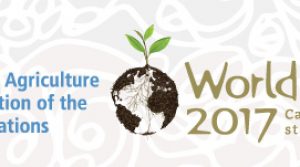World Soil Day
Wednesday 6th December 2017 in EIA & Soils

By Sophie Webb, Associate at Reading Agricultural Consultants.
The British Society of Soil Science hosted presentations and a lively debate on Tuesday 5th December, also known as World Soils Day. Sophie Webb and Dr Lewis Peake attended the meeting for RAC, held at the Royal College of Physicians, Regents Park .
The presentations were delivered by a diverse group of speakers, from the French National Institute for Agricultural Research (INRA), the Centre for Ecology and Hydrology, Rothamsted Research and from the University of Reading. Topics covered were centred around the ‘4 per mil’ initiative and provided an insight into the aims, the challenges and the implications of the idea.
Dr Claire Chenu, from INRA, explained that the ‘4 per mil’ initiative was launched at the COP 21 and looks to soils as a tool for improving food security and buffering the effects of global greenhouse gas emissions by growing carbon stocks. Globally, there is estimated to be 2400 gigatonnes of organic carbon stored in the top 2m of soil. Global carbon emissions are estimated at 8.9 gigatonnes: or 0.4% of that in the soil store. The ‘4 per mil’ initiative introduces the idea that by increasing sequestered carbon by 0.4%, carbon emissions could be offset.
At the start of the meeting delegates were polled as to whether they believed that this was an achievable goal in the UK (approximately 10 % thought so). But, during her talk Dr Chenu emphasised that we should not focus on the precise numbers but treat the initiative as an aspirational goal. She also stressed that soil health and food security were at least as important and that climate change mitigation should be seen as a co-benefit rather than the critical criterion. Indeed, all present agreed overwhelmingly that (1) increasing soil C globally would be beneficial and (2) overall improvement is possible, despite severe problems in specific places or contexts. She also discussed research that is still needed to understand the variable carrying capacities of different soil types and the balance between labile SOC (for productivity) and stable SOC (for sequestration).
There is no single approach that will deliver this result and indeed some of the main challenges include: the sheer diversity of UK soils; levels of funding available (80% of Natural Resources Wales’ monitoring budget is directed toward water); and perhaps greatest of all, the increasing demand on our soils for greater crop yields, including yields of houses.
Bridgett Emmett (CEH) gave an impassioned talk counteracting those scientists who are pessimistic and obstructive regarding the possibility of making any progress towards the 4 per mil goal, but at the same time her message was full of common sense and pragmatism about the road ahead. One interesting but worrying change her team had observed in uncultivated soils was an apparent loss of SOC due to a reduction in air pollution: less acid rain had raised pH levels, and perhaps led to increased respiration. She also lamented the decline of national soil monitoring since 2007.
David Powlson (Rothamsted) summarised the ways society can increase SOC or reduce its loss. His talk was balanced but tinged with a large dose of scepticism, perhaps by over-emphasising the literal aim of 0.4 %.
The subsequent debate was very lively! Topics, some controversial, included a return to mixed farming, composting urban waste, reforesting moorland currently used for shooting grouse, creating a soil health “MOT” for farmers with penalties for the worst offenders, compost toilets, biochar, lack of incentives for tenant farmers to improve their soil, and banning harvesting maize on sloping land in winter!
Whilst the global and national changes are the big picture, there was also emphasis on the smaller picture; that change can start at home. Dr Joanna Clark of the University of Reading emphasised that we are all individual land managers, whether on a garden or even window-box scale. Taking responsibility for our own soils, making good land management decisions and working to build our own carbon stores has the potential to lead to a cumulative contribution to improving our local environment.
The final poll suggested few had changed their opinion!

